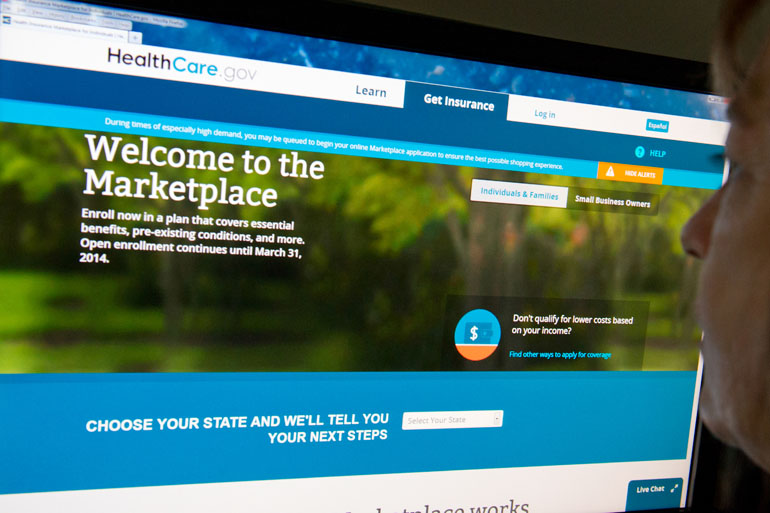Signing up for coverage on the health insurance marketplace should be easier for some people this fall because new federal rules will allow brokers and insurers to handle the entire enrollment process online, from soup to nuts. Some consumer advocates are concerned, though, that customers going this route won’t get the comprehensive, impartial plan information they need to make the best decision due to the financial self-interest of insurers and brokers.
“Facilitating the participation of brokers and getting web brokers involved is a good thing for the market,” said Timothy Jost, emeritus professor at Washington and Lee University School of Law in Virginia and an expert on health reform. But there are risks for consumers. “If you’re enrolling with a web broker, you could see ‘best deals’ that often aren’t the best deal for you but are the best deal for the people who are marketing them.”
The guidance was released earlier this month by the Centers for Medicare & Medicaid Services, which oversees the online marketplaces. It will streamline the enrollment process for consumers who work directly with an insurer or broker to shop for coverage on healthcare.gov, the federal marketplace in more than 30 states. States that run their own marketplaces aren’t affected by this change.
 Insuring Your Health
Insuring Your HealthIn the past, consumers could start the online enrollment process with a broker or insurer, but then they had to bounce off the broker’s or insurer’s website to go to the federal marketplace website to see if they were eligible for premium tax credits, among other things. In theory, they then could return to the insurer or web broker to complete the enrollment process. In practice, many didn’t — though they may have enrolled elsewhere, either completing the process on healthcare.gov or with another vendor.
This fall, healthcare.gov consumers with straightforward enrollment needs will be able to complete the entire process on one website. Complex cases and those involving a special enrollment period, for example, will still have to go through the original process.
The staff at online health insurance broker eHealth is thrilled with the change.
“It’s a big deal,” said Nate Purpura, vice president of consumer affairs at eHealth. “Many people, including our CEO, have been to Washington, D.C., multiple times to explain the benefits of being able to help in this way.”
Its website, which works with 180 insurance carriers nationwide, offers about 75 percent of the plans that are available on healthcare.gov, Purpura said.
That’s a problem, say some policy analysts. Federal rules require web brokers to display basic information about all the plans that are available on the federal marketplace, whether or not they actually sell them. It includes the name of the plan and insurer that offers it, the type of plan — HMO, PPO, EPO — and metal level (bronze, silver, gold or platinum). Web brokers must also publish a disclaimer that says the website information about all the available marketplace plans might not be complete and provide a link to healthcare.gov.
But the information web brokers present about plans they sell and get a commission for may be much more comprehensive than the information provided about plans they don’t handle.
On a broker’s website, “consumers won’t necessarily have the full range of options,” said Elizabeth Hagan, associate director of coverage initiatives at Families USA, a consumer advocacy group. “On healthcare.gov, the plan display is the same for all the options, and consumers have the ability to sort plans based on what they want.”
CMS suggests that brokers not sort their plans in such a way that consumers could be steered to policies from which brokers receive a commission. It also suggests that brokers not run ads or information about other insurance products in the marketplace plan selection area. But these are suggestions, not requirements.
In addition, some analysts are concerned that people who don’t sign up through healthcare.gov won’t receive important notifications about their coverage from insurers and web brokers. In the past, for example, some consumers have lost their coverage after enrolling outside healthcare.gov because they weren’t directed to make their initial “binder” payment, or first month’s premium, said Sarah Lueck, a senior policy analyst at the Center on Budget and Policy Priorities, which has filed comments on proposed enrollment rules.
Enrollment this fall will run for just six weeks, from Nov. 1 to Dec. 15, significantly shorter than in previous years. Encouraging brokers and insurers to sign people up may help boost enrollment, some say.
“This is another important step to help create stability in the health insurance market,” CMS Administrator Seema Verma said in the press release announcing the new process.
But some analysts remain concerned that details about how consumers’ privacy and security will be protected under the new system are still too vague.
“This is really sensitive information, people’s tax information, which needs to be highly protected,” said Jost. “There are a lot of concerns with confidentiality and privacy. I have some concerns about fraud.”
Please visit kffhealthnews.org/columnists to send comments or ideas for future topics for the Insuring Your Health column.







